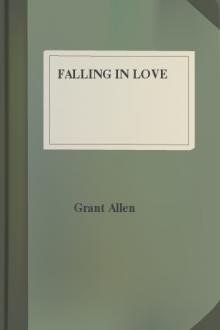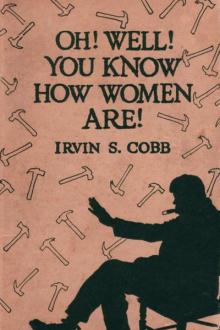Falling in Love by Grant Allen (different e readers .txt) 📕

- Author: Grant Allen
- Performer: -
Book online «Falling in Love by Grant Allen (different e readers .txt) 📕». Author Grant Allen
It is interesting to note too that while the Men of the Time still retained (to be frankly evolutionary) many traces of the old monkey-like progenitor, the horses which our old master has so cleverly delineated for us on his scrap of horn similarly retained many traces of the earlier united horse-and-donkey ancestor. Professor Huxley has admirably reconstructed for us the pedigree of the horse, beginning with a little creature from the Eocene beds of New Mexico, with five toes to each hind foot, and ending with the modern horse, whose hoof is now practically reduced to a single and solid-nailed toe. Intermediate stages show us an Upper Eocene animal as big as a fox, with four toes on his front feet and three behind; a Miocene kind as big as a sheep, with only three toes on the front foot, the two outer of which are smaller than the big middle one; and finally a Pliocene form, as big as a donkey, with one stout middle toe, the real hoof, flanked by two smaller ones, too short by far to reach the ground. In our own horse these lateral toes have become reduced to what are known by veterinaries as splint bones, combined with the canon in a single solidly morticed piece. But in the pre-Glacial horses the splint bones still generally remained quite distinct, thus pointing back to the still earlier period when they existed as two separate and independent side toes in the ancestral quadruped. In a few cave specimens, however, the splints are found united with the canons in a single piece, while conversely horses are sometimes, though very rarely, born at the present day with three-toed feet, exactly resembling those of their half-forgotten ancestor, the Pliocene hipparion.
The reason why we know so much about the horses of the cave period is, I am bound to admit, simply and solely because the man of the period ate them. Hippophagy has always been popular in France; it was practised by pre-Glacial man in the caves of Périgord, and revived with immense enthusiasm by the gourmets of the Boulevards after the siege of Paris and the hunger of the Commune. The cave men hunted and killed the wild horse of their own times, and one of the best of their remaining works of art represents a naked hunter attacking two horses, while a huge snake winds itself unperceived behind close to his heel. In this rough prehistoric sketch one seems to catch some faint antique foreshadowing of the rude humour of the 'Petit Journal pour Rire.' Some archæologists even believe that the horse was domesticated by the cave men as a source of food, and argue that the familiarity with its form shown in the drawings could only have been acquired by people who knew the animal in its domesticated state; they declare that the cave man was obviously horsey. But all the indications seem to me to show that tame animals were quite unknown in the age of the cave men. The mammoth certainly was never domesticated; yet there is a famous sketch of the huge beast upon a piece of his own ivory, discovered in the cave of La Madelaine by Messrs. Lartet and Christy, and engraved a hundred times in works on archæology, which forms one of the finest existing relics of pre-Glacial art. In another sketch, less well known, but not unworthy of admiration, the early artist has given us with a few rapid but admirable strokes his own reminiscence of the effect produced upon him by the sudden onslaught of the hairy brute, tusks erect and mouth wide open, a perfect glimpse of elephantine fury. It forms a capital example of early impressionism, respectfully recommended to the favourable attention of Mr. J.M. Whistler.
The reindeer, however, formed the favourite food and favourite model of the pre-Glacial artists. Perhaps it was a better sitter than the mammoth; certainly it is much more frequently represented on these early prehistoric bas-reliefs. The high-water mark of palæolithic art is undoubtedly to be found in the reindeer of the cave of Thayngen, in Switzerland, a capital and spirited representation of a buck grazing, in which the perspective of the two horns is better managed than a Chinese artist would manage it at the present day. Another drawing of two reindeer fighting, scratched on a fragment of schistose rock and unearthed in one of the caves of Périgord, though far inferior to the Swiss specimen in spirit and execution, is yet not without real merit. The perspective, however, displays one marked infantile trait, for the head and legs of one deer are seen distinctly through the body of another. Cave bears, fish, musk sheep, foxes, and many other extinct or existing animals are also found among the archaic sculptures. Probably all these creatures were used as food; and it is even doubtful whether the artistic troglodytes were not also confirmed cannibals. To quote Mr. Andrew Lang once more on primitive man, 'he lived in a cave by the seas; he lived upon oysters and foes.' The oysters are quite undoubted, and the foes may be inferred with considerable certainty.
I have spoken of our old master more than once under this rather question-begging style and title of primitive man. In reality, however, the very facts which I have here been detailing serve themselves to show how extremely far our hero was from being truly primitive. You can't speak of a distinguished artist, who draws the portraits of extinct animals with grace and accuracy, as in any proper sense primordial. Grant that our good troglodytes were indeed light-hearted cannibals; nevertheless they could design far better than the modern Esquimaux or Polynesians, and carve far better than the civilised being who is now calmly discoursing about their personal peculiarities in his own study. Between the cave men of the pre-Glacial age and the hypothetical hairy quadrumanous ancestor aforesaid there must have intervened innumerable generations of gradually improving intermediate forms. The old master, when he first makes his bow to us, naked and not ashamed, in his Swiss or French grotto, flint scalpel in hand and necklet of bear's teeth dropping loosely on his hairy bosom, is nevertheless in all essentials a completely evolved human being, with a whole past of slowly acquired culture lying dimly and mysteriously behind him. Already he had invented the bow with its flint-tipped arrow, the neatly chipped javelin-head, the bone harpoon, the barbed fish-hook, the axe, the lance, the dagger, and the needle. Already he had learnt how to decorate his implements with artistic skill, and to carve the handles of his knives with the figures of animals. I have no doubt that he even knew how to brew and to distil; and he was probably acquainted with the noble art of cookery as applied to the persons of his human fellow creatures. Such a personage cannot reasonably be called primitive; cannibalism, as somebody has rightly remarked, is the first step on the road to civilisation.
No, if we want to get at genuine, unadulterated primitive man we must go much further back in time than the mere trifle of 250,000 years with which Dr. Croll and the cosmic astronomers so generously provide us for pre-Glacial humanity. We must turn away to the immeasurably earlier fire-split flints which the Abbé Bourgeois—undaunted mortal!—ventured to discover among the Miocene strata of the calcaire de Beauce. Those flints, if of human origin at all, were fashioned by some naked and still more hairy creature who might fairly claim to be considered as genuinely primitive. So rude are they that, though evidently artificial, one distinguished archæologist will not admit they can be in any way human; he will have it that they were really the handiwork of the great European anthropoid ape of that early period. This, however, is nothing more than very delicate hair-splitting; for what does it matter whether you call the animal that fashioned these exceedingly rough and fire-marked implements a man-like ape or an ape-like human being? The fact remains quite unaltered, whichever name you choose to give to it. When you have got to a monkey who can light a fire and proceed to manufacture himself a convenient implement, you may be sure that man, noble man, with all his glorious and admirable faculties—cannibal or otherwise—is lurking somewhere very close just round the corner. The more we examine the work of our old master, in fact, the more does the conviction force itself upon us that he was very far indeed from being primitive—that we must push back the early history of our race not for 250,000 winters alone, but perhaps for two or three million years into the dim past of Tertiary ages.
But if pre-Glacial man is thus separated from the origin of the race by a very long interval indeed, it is none the less true that he is separated from our own time by the intervention of a vast blank space, the space occupied by the coming on and passing away of the Glacial Epoch. A great gap cuts him off from what we may consider as the relatively modern age of the mound-builders, whose grassy barrows still cap the summits of our southern chalk downs. When the great ice sheet drove away palæolithic man—the man of the caves and the unwrought flint axes—from Northern Europe, he was still nothing more than a naked savage in the hunting stage, divinely gifted for art, indeed, but armed only with roughly chipped stone implements, and wholly ignorant of taming animals or of the very rudiments of agriculture. He knew nothing of the use of metals—aurum irrepertum spernere fortior—and he had not even learnt how to grind and polish his rude stone tomahawks to a finished edge. He couldn't make himself a bowl of sun-baked pottery, and, if he had discovered the almost universal art of manufacturing an intoxicating liquor from grain or berries (for, as Byron, with too great anthropological truth, justly remarks, 'man, being reasonable, must get drunk'), he at least drank his aboriginal beer or toddy from the capacious horn of a slaughtered aurochs. That was the kind of human being who alone inhabited France and England during the later pre-Glacial period.
A hundred and seventy thousand years elapse (as the play-bills put it), and then the curtain rises afresh upon neolithic Europe. Man meanwhile, loitering somewhere behind the scenes in Asia or Africa (as yet imperfectly explored from this point of view), had acquired the important arts of sharpening his tomahawks and producing hand-made pottery for his kitchen utensils. When the great ice sheet cleared away he followed the returning summer into Northern Europe, another man, physically, intellectually, and morally, with all the slow accumulations of nearly two thousand centuries (how easily one writes the words! how hard to realise them!) upon his maturer shoulders. Then comes the age of what older antiquaries used to regard as primitive antiquity—the age of the English barrows, of the Danish kitchen middens, of the Swiss lake dwellings. The men who lived in it had domesticated the dog, the cow, the sheep, the goat, and the invaluable pig; they had begun to sow small ancestral wheat and undeveloped barley; they had learnt to weave flax and wear decent clothing: in a word, they had passed from the savage hunting condition to the stage of barbaric herdsmen and agriculturists. That is a comparatively modern period, and yet I suppose we must conclude with Dr. James Geikie that it isn't to be measured by mere calculations of ten or twenty centuries, but of ten or twenty thousand years. The perspective of the past is opening up rapidly before us; what looked quite close yesterday is





Comments (0)